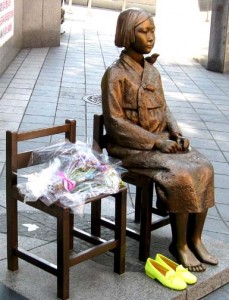 That quiet lady with the bronze tan and the steely gaze is sure causing a lot of trouble for Japan. She’s got the time to sit across the street from Japan’s embassy in Seoul all day and all night, and no one’s going to remove her, either. She’s bolted to the sidewalk.
That quiet lady with the bronze tan and the steely gaze is sure causing a lot of trouble for Japan. She’s got the time to sit across the street from Japan’s embassy in Seoul all day and all night, and no one’s going to remove her, either. She’s bolted to the sidewalk.
She’s a sculpture, and she, the bird on her shoulder, and the empty chair next to her have been sitting across from the Japanese embassy since December, 2011, facing each and every individual who comes and goes through the embassy’s front door. As we write this, 5 buses of Korean riot police are in close proximity, as rumor has it that yet another group of Koreans will protest in favor of a sincere apology from Japan, for kidnapping, buying, or cajoling an estimated 140,000 Korean women to serve as sex slaves for Japanese troops in WWII. They are called halmoni, by the Koreans (meaning ‘grandmothers’), and ‘comfort women’ by the Japanese military. Most were between 13 and 16 years of age, and serviced 30-40 men per day.
The story’s a good one to know, as you won’t find many Koreans — even those of the younger generation — who profess a lot of love for the Japanese. In World War II, the Japanese military enforced this policy of institutionalized rape of Korean girls. The Japanese have made a habit of trouncing Korean culture, which began before that war. In 1911, under Japanese occupation, the Japanese tore down 90% of Seoul’s historical Gyeongbokgung Palace, just to remind the Koreans that there wasn’t really a Korea anymore. Today, the Koreans are still in the long and expensive process of rebuilding it. Ultimately, Korea couldn’t do much to turn back the clock on these two events which, among many others, have colored Korean national opinion on Japan in general. But we imagine there wasn’t much hand-wringing in Korea when the bombs dropped on Hiroshima and Nagasaki (might as well add Nanking to that list as well).
The government of Japan has formally protested that the placement of the statue facing its embassy breaches the Vienna Convention on Diplomatic Relations, and a Japanese politician, Nobuyuki Suzuki, tied his own “protest pole” to another such sculpture in Seoul. The issue is hot, and that’s why there’s police presence of one sort or another at the Japanese Embassy in Seoul these days. Regardless of claims by the Japanese that they’ve made reparations, a lot of Koreans just aren’t buying it. “Rape and kill our women,” they seem to be saying, “and decades later, we’ll still have the issue in front of the eyes of the world.” Great injustices don’t fade away easily. Especially when that bronze lady with the empty chair just sits outside your embassy and stares… and stares… and stares…
Leave a Reply